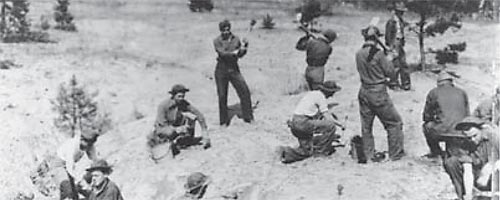History & Culture
National Background
The U.S. Forest Service is a federal agency managed under the U.S.Department of Agriculture. The Creative Act of 1891 created the forest reserves from land that was public domain. Congress passed the Organic Act of 1897 to improve and protect forests or secure favorable water flows and to furnish a continuous supply of timber for citizens of the United States. The Act of February 1, 1905 placed the administration of the Nation's forest reserves under the Department of Agriculture. The Weeks Act of 1911authorized the purchase of private lands to establish National Forests. This allowed the creation of National Forests in the east where there was essentially no public domain lands.
The Multiple Use-Sustained Yield Act of 1960 stated that National Forests shall be administered for outdoor recreation, range, timber, watershed, and wildlife and fish purposes. This administration must be carried out in a way that provides the achievement and maintenance in perpetuity of a high level annual or regular periodic output of the various renewable resources without impairment of the productivity of the land.
National Forest in Georgia
The lands that make up Georgia's beautiful National Forests were once the lands nobody wanted. The early history of Georgia is a tale of abuse and overuse of the fragile ecosystems. Hydraulic mining for gold, cut and leave practices of early timber companies,wildfires, over-grazing and unregulated hunting and fishing led to a forest that was in need of extensive restoration efforts.
The Forest Service purchased 31,000 acres in four North Georgia counties in 1911 for $7 per acre. In the beginning, the Chattahoochee was part of the Nantahala and Cherokee National Forests in North Carolina and Tennessee. Many of the early purchases were old homesteads and abandoned farm lands.
On July 9, 1936, the Chattahoochee National Forest was proclaimed as a separate National Forest. At that time, Forest Service managers began to restore these lands by planting trees, fighting wildfires, controlling erosion and introducing wildlife and fish back into their natural habitat. As a result of a concentrated effort by the Forest Service and the Department of Natural Resources personnel, the deer and trout populations which had been virtually eliminated, were brought back to today's healthy and productive level. Today's estimate of the deer population is more than 30,000 animals and a turkey population of over 6,000 birds.
Likewise in 1970, the bear population on the Chattahoochee totaled 106 bears. After 20years of continually managing the habitat for this animal, the Chattahoochee today boasts a healthy bear population of more than 650 animals.
Here is a more thorough treatment of the History of the Chattahoochee-Oconee National Forests.
Features
Heritage and Tribal Program on the Chattahoochee-Oconee National Forests

The purpose of the Heritage Program is to protect significant heritage resources, to share their values with the American people, and to contribute relevant information and perspectives to natural resource management. In so doing we will:
- ensure that future generations will have an opportunity to discover the human story etched on the landscapes of our national forests and grasslands;
- make the past come alive as a vibrant part of our recreational experiences and community life; and
- connect people to the land in a way that will help us better understand and manage forest ecosystems.
Celebrating the Centennial of the Weeks Act
Sometimes Congress passes a law that surpasses the expectations of those who drafted it and worked so hard for its passage. Few people, if any, could have known the magnitude of the legacy of the Weeks Act. From this law was born nearly all the national forests east of the Mississippi River. Here we commemorate the legacy of the Weeks Act in Georgia with links to additional resources.
Alerts & Warnings
- Tallulah River Road Construction to Begin
- Before riding your UTV, Educate Yourself!
- Tumbling Creek Road (FSR 22) Reopened
- Houston Valley Now Scan & Pay
- Track Rock Petroglyphs
- Flatlands Road (FSR 256 and FSR 637) Closed
- Road Closures on the Chattooga River Ranger District
- Coleman River Rd (FSR #54) Closure
- CAUTION Waterfall Dangers
- CALL BEFORE YOU HAUL - ATV and OHV
- Panther Creek Trail Temporary Hiker Restrictions
- Don't Move Firewood!


